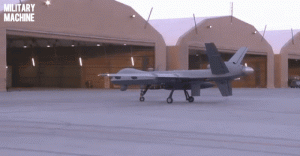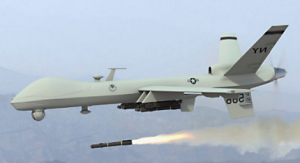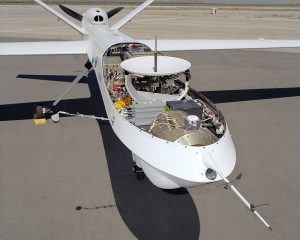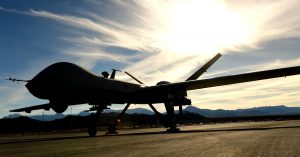General Atomics MQ-9 Reaper
The General Atomics MQ-9 Reaper drone is more than just a larger and better armed cousin of the iconic Predator drone; General Atomics designed “The Reaper” from the ground up as an unparalleled airborne assassin.
 Unique Role:
Unique Role:
This ultra-quiet and low-radar-profile hunter is capable of stalking a target for up to 14 hours before deploying two tons of ordnance, including 500lb JDAM’s, with pinpoint accuracy. In just nine years of service, the Reaper has put hundreds of “warheads on foreheads” and amassed a long record of combat success that no manned aircraft in the War on Terror has yet matched.

Assassin Skills:
While the US Air Force fields much faster warplanes that can carry far more firepower, this hunter-killer’s real edge comes from its unique sensor suite and unmatched endurance. By replacing half their payload with an external fuel pod, MQ-9’s have patrolled for up to 42 hours under combat conditions. This unprecedented ability to loiter and track an enemy leader’s every move is perhaps the biggest draw to employing Reapers in battle.
Mission Profile:
Every “simple” MQ-9 strike tends to unearth many more juicy and time-sensitive targets, but the platform can only carry so much ordnance. It’s quite common in the War on Terror for Reapers to abandon their original mission and attack high-value “targets of opportunity”, usually senior terrorist leaders that rarely appear in the open. These targets would have likely been missed entirely by a traditional manned attack, as the fighter zipped in and out of the battlezone in a matter of minutes.

Sensors:
The MQ-9’s other game-changing advantage stems from the Multi-Spectral Targeting System (MTS-B). This device deploys a robust suite of visual sensors for targeting even fast-moving enemies. The system integrates side-searching radar, infrared sensors, image-intensified TV cameras, laser range finder/designator, and laser illuminator. Whereas most combat aircraft rely on either a ground spotter or hasty analysis made by the airborne bombardier, drone operators can usually carefully evaluate targets in real-time.

Crew:
Finally, most MQ-9 missions are controlled by a pilot and sensor operator who work out of Creech Air Force Base in Arizona. So far away from the distractions of combat, the crew can simply pick up the phone and access the latest intelligence briefs, advice from specialists, or guidance from senior leadership. All resources not readily available in the cockpit of a bomber, but which improve the accuracy and lethality of these drones exponentially.
Combat History:
While the details of most MQ-9 missions are still classified, the Reaper has harvested hundreds and perhaps even thousands of terrorists. Not just in Iraq and Afghanistan, but also in clandestine surgical strikes throughout North and Central Africa and Southwest Asia. The MQ-9 Reaper is suspected of dispatching dozens of senior Taliban, Al Qaeda, ISIS, Boko Haram and Al-Shabaab leaders. Perhaps the most famous target the US government publically acknowledges is ISIS member Mohammed Emwazi. AKA “Jihadi John,” he was responsible for executing several American and European hostages in Syria.

Future Role:
Regardless of how you feel about the American government’s controversial drone assassination program, the MQ-9 Reaper was the machine that made this new theater of war possible. And judging by the countless unmanned combat aircraft programs under development, most based on the Reaper’s frame, this drone represents the future of air warfare.
See more captivating images of the MQ9 Reaper.
See MQ-9 Reaper Specifications
| Primary Function: Armed reconnaissance and Close Air Support |
| Contractor: General Atomics Aeronautical Systems, Inc. |
| Power Plant: Honeywell TPE331-10GD turboprop engine |
| Thrust: 900 shaft horsepower maximum |
| Wingspan: 66 feet (20.1 meters) |
| Length: 36 feet (11 meters) |
| Height: 12.5 feet (3.8 meters) |
| Weight: 4,900 pounds (2,223 kilograms) empty |
| Maximum Takeoff Weight: 10,500 pounds (4,760 kilograms) |
| Fuel Capacity: 4,000 pounds (602 gallons) |
| Payload: 3,750 pounds (also 1,701 kilograms) |
| Speed: cruise speed around 230 mph (200 knots) |
| Range: 1,150 miles (also 1,000 nautical miles) |
| Ceiling: Up to 50,000 feet (also 15,240 meters) |
| Armament: combination of AGM-114 Hellfire missiles, also GBU-12 Paveway II and also GBU-38 Joint Direct Attack Munitions |
| Crew (remote): two (pilot and also sensor operator) |
| Unit Cost: $64.2 million (also includes four aircraft, sensors, GCSs, and Comm.) (fiscal 2006 dollars though) |
| Initial Operating Capability: October 2007 |
| Inventory: 93 all total |
Watch This Video Of The MQ-9 Reaper In Action

